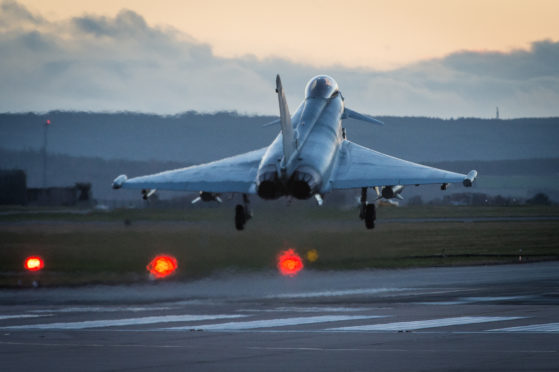RAF Lossiemouth crews tasked with protecting the UK from Russian intruders have had their busiest year since 2015.
Typhoon jets based in Moray were launched six times to track Vladimir Putin’s planes between January and the end of November.
The latest statistics from the Ministry of Defence have revealed that crews at RAF Lossiemouth have launched more QRA (quick reaction alert) missions during 2018 than they have done for the last three years while patrolling the sky.
>> Keep up to date with the latest news with The P&J newsletter
A £400million expansion project is currently under way at the base, and during a visit to launch the work Defence Secretary Gavin Williamson described an “increasing” threat from Russia.
During 2020, nine submarine-hunting P-8 Poseidon spy planes will join the fight to track submarines lurking under the surface of the North Atlantic.
Moray MP Douglas Ross said: “The fact that this has been the busiest year since 2015 with six call-outs shows how vital this facility is to the safety and protection of the UK.
“This reiterates the crucial role Moray and RAF Lossiemouth play as a major part of the UK defence footprint.
“It’s a role that will continue to grow with the significant investment at the base by the UK Government in the months and years ahead.”
Bombers from Russia approaching are routinely operated by UK radar before QRA orders are given.
Typhoon crews are scrambled for the launches in order to determine the identification of an aircraft either approaching or within Nato airspace without approval or without identifying themselves.
Personnel at RAF Lossiemouth are tasked with monitoring the north of the country while maintaining a constant state of readiness 24 hours a day to deter intruders.
Armed Forces Minister Mark Lancaster said that crews in Moray played a critical role in protecting the UK.
“As we’ve seen in recent years our world-leading RAF stand ready to protect our sky at a moment’s notice,” he said.
“Be it intercepting Russian aircraft probing the boundary of our airspace or responding to a potential terrorist threat – their rapid response ensures our airspace and our people are safe.”
The new squadron of P-8s at RAF Lossiemouth will also be armed with anti-submarine torpedoes and will also be capable of launching search and rescue operations.
A hanger to house up to three of the aircraft as well as a tactical operations centre, training simulators and squadron accommodation is currently under construction at the base.
The first of the planes will enter service for the RAF at Kinloss in 2020.
